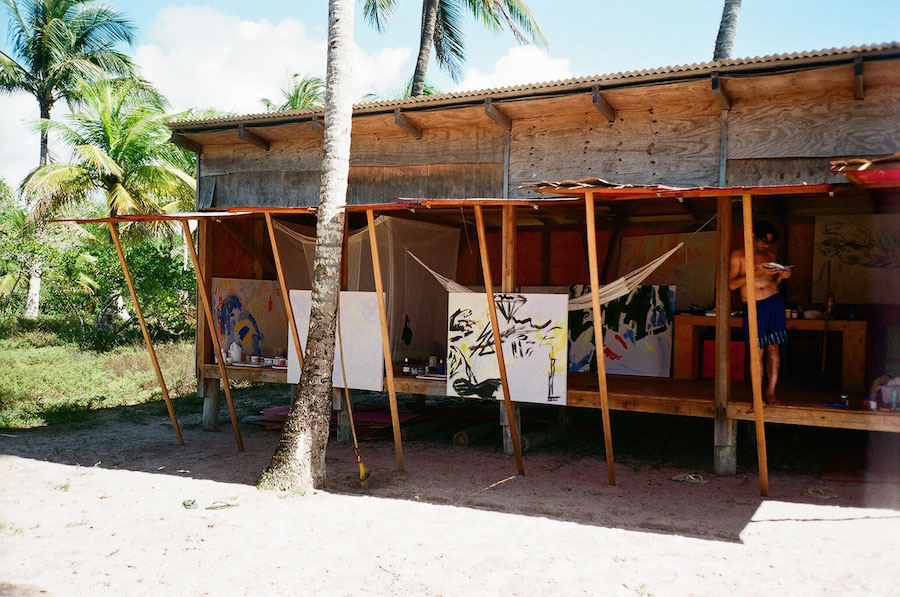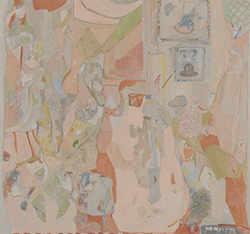[nemus_slider id=”51787″]
–
In July 2015 Stefania Batoeva and Adriano Costa reside at TwoHotel, an artists’ guesthouse build by Fabian Marti in Piracanga Beach in Bahia, Brazil. The artworks produced during the residency, organized by Emalin, are presented in an old garage in Camden Town, London.
We asked some questions to Stefania Batoeva and Adriano Costa.
ATP: Could you introduce me to your residency in Brazil? How was your typical day there?
Stefania Batoeva: The days on the equator are quite short, only a few hours of light. This meant that painting time was limited. I’d wake up and pretty much start painting; the set up there made this possible, Fabian’s Two Hotel was great. There was a simplicity and closeness to everything. The ocean offered a good break; it acted as a reset of the mind. Painting there was intense. I tried to focus as early as possible. I’d work on one or two paintings each day. This sense of urgency was important to me; it contradicted the deliberately relaxed nature of the place. I was reading about the 2008 financial crash and what led to it (Michael Lewis’ The Big Short), whilst everything around moved at a delayed pace.
ATP: Did the new location have any influence on the production of your work?
SB: Yes, I really think so – both in my way of painting and in content. There is a very special quality there, hard to describe – a heart-breaking beauty and a sadness too. And the nature is grand and petrifying. At night, the ocean waves violently dig out and reshape the beach, to be found completely flat and expansive in the morning, really bright and soft – hard to see, almost fluorescent. Huge and it’s like it’s not there. All this fitted really well with what I was doing at the time. I went on to Sao Paulo after and there had a big effect on me and my work too.
Adriano Costa: I got impressed by the house. I’ve been told Fabian Marti brought some engineers from Switzerland to build it. It’s quite weird when you compare the house with the typical houses from the “neighborhood” ( they are quite hot inside… made out of bricks…) because it has some peculiarities (built with a really cheap material that works a lot…. the house can be completely open …. it’s delicious inside… windy). So: I think the residency follows it. It’s super open… completely different from the projects I’ve been taking part. I made my paintings and drawings in the sand (you can see it in the works hahaha) without a previous research or something like that. It was not imposed, but, I’m sure, the work produced in Piracanga carry this sense of freedom.
ATP: Close to TwoHotel there’s a famous hippy community. Do you think this old movement from the last Century still has a connection with its original ideas of freedom and peace or is it just a mere disguise for neocolonialism?
SB: Every day we had food at this settlement, 5 min away down an overgrown path. I wouldn’t call it a hippy community really. For me it linked more to my reading than the heavenly environment it was set within. It felt more like a business than a hippy commune in the 60’s sense. It was structured and organised by rules (written on laminated pieces of paper, pinned on things around the place). Famous for it’s aura reading classes and other meditation teachings the place offered rather costly packages, which included a stay at the hotel “huts” – front line to the beach. No smoking or drinking was allowed on their loosely defined premises. I found it fascinating.
AC: I think Brazil still draws this fascination…. about the exoticism… What annoys me sometimes it’s the fact that the “explorers” don’t give back anything… Obviously, our residency was different and I’m proud of having been part of it. It’s nice that you can find a place apart from the caos if you want it and can pay it, obviously, … the hippie community it’s quite expensive…. but it works: they do amazing vegana food and they have INTERNET…. so: I love them.
ATP: You come from different countries with very different cultures. How was working together during the residency?
SB: Spending that time there with Leo, Adriano and Chateau was priceless. It’s impossible to sum up here. It was very special. I’d try and finish a painting in the afternoon. If I did, it felt good as the sun started to set around 5pm. We’d have a beer, maybe a swim and then we’d go to the “hippies” for some early dinner. Sometimes we skipped dinner and drank and smoked instead. We talked a lot.
AC: Working with a Bulgarian/British artist and an Austrian curator was just awesome. I’m sure that the place ( the whole situation ) made us feel quite comfortable, sharing the responsibilities, drinking hot beer ( a curse for a Brazilian guy like me … ) talking about art ( not just about OUR art ) politics and Arnold Schwarzenegger, for instance hahahaha. It was intense… with the unforgettable red river in front of the house and the beach…. kilometers without a single person. Dream…
ATP: In this exhibition you’re showing artworks you produced this summer during your residency at TwoHotel, in Brasil. Now you’re showing them in an old garage in London. Have the different location and the passing of time played any change in your relationship with the artworks? How does it feel to look at them now?
SB: There was a gap of a few months between Bahia and the show in London. It felt like a lot had happened in-between. When I was painting in Bahia I was “polluting” the experience with other things, stories of subprime mortgage fraud, noisy and often-aggressive music on my headphones. Mentally I was hardly cut off from my normal life. But I was alert in a different way there, taking in new, powerful stuff. When the time came to leave, we rolled up the works and somehow sealed all of that inside. Ending up in Camden was strange but it made sense. Camden complicated matters further, which I think was important. The work we produced wasn’t left alone in peace; it had to fight for itself, like a kid at a new school. Making a show there was a good end for a project that somehow engaged with a global fluidity of production.
AC: Showing those works in London is quite interesting. It’s about communication and testing in loco if Art has this “braking barriers” power… I think it has! I’m a believer hahahah Obviously the drawings, sculptures and paintings assume a new role. The space, temperature, colors are new… let’s see how they work. They need to survive without the Two Hotel stories… It’s a challenge.












